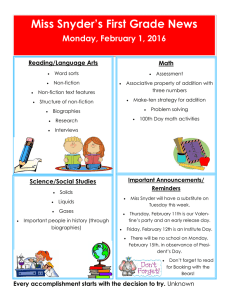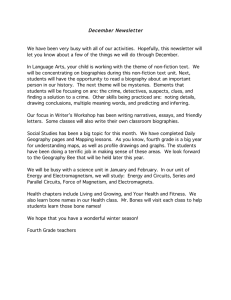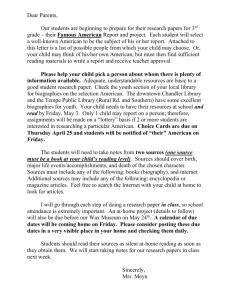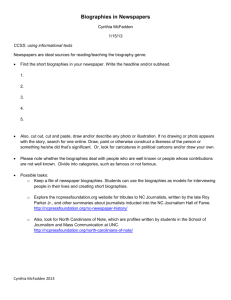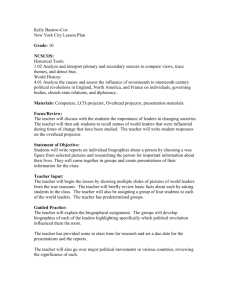MADISON PUBLIC SCHOOL DISTRICT GRADE 1 SOCIAL STUDIES
advertisement
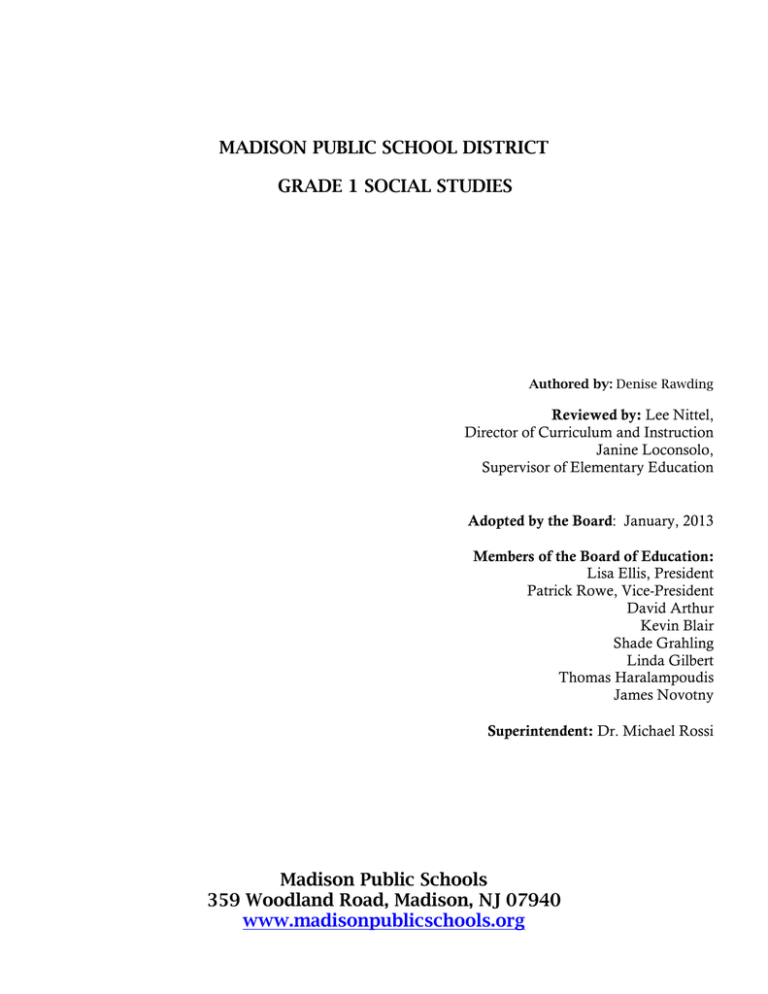
MADISON PUBLIC SCHOOL DISTRICT GRADE 1 SOCIAL STUDIES Authored by: Denise Rawding Reviewed by: Lee Nittel, Director of Curriculum and Instruction Janine Loconsolo, Supervisor of Elementary Education Adopted by the Board: January, 2013 Members of the Board of Education: Lisa Ellis, President Patrick Rowe, Vice-President David Arthur Kevin Blair Shade Grahling Linda Gilbert Thomas Haralampoudis James Novotny Superintendent: Dr. Michael Rossi Madison Public Schools 359 Woodland Road, Madison, NJ 07940 www.madisonpublicschools.org I. OVERVIEW This Madison School District social studies curriculum adheres to the belief that social studies education should foster, for all students, the ability to understand their world and to have an appreciation for the heritage of America with a high degree of literacy in civics, history, economics, and geography. Our curriculum leads students from an understanding of oneself and one's immediate surroundings, to the greater community of Madison and New Jersey, and eventually to an understanding of American traditions and democratic values. II. RATIONALE The purpose of social studies education is to provide students with the opportunity to learn the knowledge, the abilities and skills, and the beliefs and values needed for competent participation as citizens. Kindergarten students will study the concept of family and learn about American holidays and symbols. In first grade, students will study map skills, basic needs and wants, and community workers. An initial understanding of history will be learned using the biographies of famous Americans. In second grade, students will move into the larger community. They will study basic geography, civics, government and economics. Students will also begin to understand their place in history through timelines. In third grade, students explore the history, demographics, geography, resources, and early settlers to New Jersey. This leads to our fourth and fifth grade study of the United States, with an emphasis on the states and regions of our country, our government, and our early years as a country. III. STUDENT OUTCOMES (Link to New Jersey Core Curriculum Standards) Economics – Basic Needs and Wants The student will: ▫ Identify various jobs and explain how workers in these jobs receive income for their work. (6.5.2,B1) ▫ Distinguish between goods and services. (6.5.4, A1) ▫ Distinguish between a want and a need and explain how to choose needed goods and services. (6.5.4, A2) IV. ESSENTIAL QUESTIONS AND CONTENT A. B. C. D. V. What are our basic needs, and where can we go to meet our needs? What are wants, and how do they differ from needs? Where can we go to meet our wants? Why do people work? What are differences between goods and services? STRATEGIES A. Students will use the neighborhood map to identify places that meet needs and wants. B. Charts and graphic organizers will be created and displayed to reinforce unit concepts. C. An economics center can be created with collections of items that are needs and wants that the students can explore and sort. D. The Exploring Where and Why CD-ROM may be used to extend and reinforce lessons. E. Check out these websites: http://www.brainpopjr.com/socialstudies/economics http://www.internet4classrooms.com VI. EVALUATION A. The unit 2 assessment and/or neighborhood map assessment (TE 76) may be given to the students upon completion of the unit. B. On-going assessment includes student performance during activities, verbal responses to the end-oflesson assessments, and an assessment of each student’s completed activity sheets. VII. REQUIRED RESOURCES A. B. C. D. E. Nystrom: Exploring Where and Why* Nystrom: Block Buddy Atlases* The Red Racer, Audrey Wood, Aladdin, 1999 Needs and Wants, Gillia M. Olson, Capstone Press, 2008 Goods and Services, Janeen R. Adil, Capstone Press, 2006 VIII. SCOPE AND SEQUENCE Unit 2 – Exploring Neighborhoods A. Lesson 2, Activity A – “What Do We Need?” B. Lesson 2, Activity B – “Where Can We Go To Meet Our Needs?” C. Lesson 3, Activity A – “Things We Want” Students will bring in pictures of things they would like to have. D. Lesson 3, Activity B – “Where Can We Go To Meet Our Wants?” E. Lesson 4, Activity A – “Why Do People Work?” Make a graphic organizer of jobs. (Save this for Activity C) F. Lesson 4, Activity B – “What Do Workers Make and Sell?” Use the neighborhood map to complete the chart. Map Place toy store toy factory Sell toys Make toys G. Lesson 4, Activity C – “How Do Some Workers Help People?” (Service) Identify jobs that provide services on the graphic organizer from Activity A. III. STUDENT OUTCOMES (Link to New Jersey Core Curriculum Standards) Map and Globe Skills The student will: ▫ Explain the spatial concepts of location, distance and direction, including: - The location of school, home, neighborhood, community, state, and country; - The location of continents and oceans. (6.2.2, A1) ▫ Explain that the globe is a model of the Earth and maps are representations of local and distant places. (6.2.2, A2) ▫ Demonstrate basic map and globe skills. (6.2.2, A3) IV. ESSENTIAL QUESTIONS AND CONTENT A. B. C. D. E. F. V. What are the similarities and differences of maps and globes? What is a continent, and what is an ocean? What are the names of the continents and oceans? Where are north, south, east, and west on a map and globe? How does a map key help us read a map? What is our world address? (planet, continent, country, state, town) STRATEGIES A. Students will use globes, neighborhood maps, United States maps, and world maps to explore maps skills. B. Students will work with partners when using atlases and globes. C. Charts will be created to compare maps and globes. D. Map skill centers can be created. The Exploring Where and Why CD-ROM may be used to extend and reinforce lessons. E. Check out these websites: http://www.smithsonianeducation.org http://www.kids.nationalgeographic.com http://www.internet4classrooms.com VI. EVALUATION A. Unit assessments for units 3, 4, and 5 may be given to the students upon completion of the units. Assessments may be modified based on the lessons that were completed. B. On-going assessment includes student performance during activities, verbal responses to the end-oflesson assessments, and an assessment of each student’s completed activity sheets. VII. REQUIRED RESOURCES A. B. C. D. E. F. G. Nystrom: Exploring Where and Why* Nystrom: Block Buddy Atlases* Zoom, Istvan Banyai, Penguin Books, 1995 Earth Dance, Joanne Ryder, Henry Holt and Co., 1996 The Seven Continents, Wil Mara, Childrens Press, 2005 The Four Oceans, Wil Mara, Childrens Press, 2005 As the Crow Flies, Gail Hartman, Aladdin, 1993 H. North, South, East, and West, Allan Fowler, Childrens Press, 1993 I. Looking Down, Steve Jenkins, Houghton Mifflin, 1995 J. Me on the Map, Joan Sweeney, Dragonfly Books, 1998 VIII. SCOPE AND SEQUENCE Unit 3 – Looking at Our Earth A. Lesson 1, Activities A & B – “What is a Model?” B. Lesson 2, Activity A – “What is a Globe?” C. Lesson 2, Activity B – “Where is the Land? Where is the Water?” D. Lesson 3, Activities A & B – “What is a Continent?” and “Can You Name the Continents?” *The chant on p. 92 may be used as a review activity. E. Lesson 4, Activities A & B – “What is an Ocean?” and “Can You Name the Oceans?” Unit 4 – What is a Map? F. Lesson 2, Activity A – “What is a Map?” G. Lesson 2, Activity B – “Where are the Continents and Oceans?” H. Lesson 4, Activity A – “What are Directions?” *Recognize up and down in relation to the Earth. I. Lesson 4, Activities B & C, “Where are North and South on a Globe and on a Map?” J. Lesson 5, Activities A & B – “Where are East and West on a Map?” K. Lesson 6, Activities A & B – “How do Maps Use Color?” and “What is a Symbol?” L. Lesson 6, Activity C – “What is a Map Key?” M. Lesson 6, Activity D – “How do Maps Show Places?” Vocabulary: coastline, mountain, river, country capital, lake, boundary N. Lesson 7, Activity B – “How Can We Measure Distance in a Neighborhood?” Unit 5 – Where Do We Live? O. Lesson 1, Activities A & B – “What Are Earth’s Continents?” and “What is Your World Address?” P. Lesson 2, Activities A & B – “Where is the United States?” and “Where in the World is the United States?” Q. Lesson 3, Activities A & B – “What is a State?” and “Where is Our State?” R. Lesson 4, Activities A & B – “Where Do We Live?” and “What is Your World Address?” S. Lesson 5, Activity B – “Can You Read a Map of the United States? T. Lesson 5, Activity C – “Can You Find Things on a Map?” III. STUDENT OUTCOMES (Link to New Jersey Core Curriculum Standards) Biographies of Famous Americans The student will: ▫ Recognize real people and fictional characters who have demonstrated responsible leadership and citizenship and identify the characteristics that have made them good examples. (6.2, D2) ▫ Recognize the names of major figures in American history, including George Washington, Abraham Lincoln, Sacajawea, Harriet Tubman, Susan B. Anthony, and Martin Luther King, Jr. (6.4, B1) ▫ Discuss the contributions of important women, African Americans, and Native Americans to United States and New Jersey history. (6.4, B2) IV. ESSENTIAL QUESTIONS AND CONTENT A. Who are some important individuals in American history? George Washington, Thomas Jefferson, Benjamin Franklin, Harriet Tubman, Abraham Lincoln, Helen Keller, Susan B. Anthony, Rosa Parks, Thomas A. Edison, Martin Luther King, Jr. B. What characteristics do these individuals possess and have in common? C. Why are these individuals important in the history of America? D. How do biographies differ from realistic fiction? E. How do the features of non-fiction writing help the reader to understand the text better? V. STRATEGIES A. Students will jot notes using their own words to hold important information. B. Charts created by the class will be displayed. The charts should be easily accessible, so students can refer to them often. C. Students will be assigned and work with a partner. D. Students will work with their partner to share out the information they have learned about their famous American through a media of their choice. E. Check out these websites: http://www.americaslibrary.gov/cgi-bin/page.cgi/aa http://www.educationalsynthesis.org/famamer/ http://www.harcourtschool.com/activity/biographies/ http://www.brainpop.com http://www.brainpopjr.com VI. EVALUATION A. The final assessment will be based on the project created by the partners. It should include important information about the famous American’s life. B. On-going assessment includes reading conferences with partners and assessment of the note-taking sheets. VII. REQUIRED RESOURCES A. Biographies from the Lives and Times series, Heinemann* B. Biographies from the First Biographies series, Heinemann* C. Biographies from the Rookie Biographies series, Scholastic* D. E. F. G. H. I. J. K. Biographies from the A Picture Book Biography series, Holiday House* Biographies from the Easy Reader Biographies series, Scholastic* Biographies from the First Biographies series, Capstone Press* Biographies from the Photo-Illustrated Biography series, Capstone Press* Sacajawea (All Aboard Reading), Joyce Milton. Grosset & Dunlap, 20011 Neil Armstrong (Rookie Biographies), Dana Meachen Rau, Children’s Press, 2003 Dr. Seuss (Rookie Biographies), Dana Meachen Rau, Scholastic, 2003 Pocahontas: An American Princess, Joyce Milton, Grosset & Dunlap, 2000 VIII. SCOPE AND SEQUENCE A. Launching/ Introduction 1 week ▫ Teacher will introduce the students to biographies of famous Americans through read-alouds and shared reading. ▫ Notice non-fiction features in text. ▫ Model how to negotiate non-fiction text. ▫ Compare a biography to a fiction book. ▫ Show different types of non-fiction: - Texts that read like stories (start to finish) - Texts that do not need to be read cover-to-cover ▫ Create a class chart of the characteristics of the famous Americans and connect these characteristics to why they are important in American history. B. Guided Practice 7 – 10 days ▫ Put baskets of biographies out for explorations. The baskets should include biographies of several people and different types of non-fiction text. ▫ Teach how careful readers use non-fiction features to help them read books. ▫ Find non-fiction features in a shared book, then partners find the features in their books and mark them with sticky notes. ▫ Create a class chart. Features of non-fiction How they help us read Possible Features to Study - Table of Contents - Index - Photographs and Illustrations - Captions - Labels - Section Headings ▫ Teach how to use the features and partners will look through the books and try to use the new feature. C. Exploration and Research of Famous Americans 7 - 10 days ▫ Students choose three individuals they are interested in studying. The teacher will assign partnerships based on the results of this information. Possible Mini-Lessons ▫ Selecting an initial focus for their work. Partners think together about what they are interested in finding out more about. ▫ Readers use the features of non-fiction to help them find information. This is continued from the Launching/Introduction, but now the students will have authentic opportunities to use the features of non-fiction to help them get information and better understand their topic. ▫ Readers notice when they are learning something new. Partners can mark the new learning with a sticky note labeled “NL” for new learning. ▫ Readers jot notes to hold important information. What does it mean to jot down a note? The information on notes is put into our own words. Note-taking sheets can be introduced. ▫ Readers look at different books to accumulate information about their topic. Notice overlapping information. Notice that books can have different information about the same thing. ▫ Readers think about the information they collect and find new questions. ▫ Readers connect the information they collect with other things they know. ▫ Readers make theories about their information and try to answer the question, Why? D. Final Project ▫ Partners will share out the information they have learned about their famous American using a media of their choice. (i.e. PowerPoint presentation, poster, writing, 3D display) ▫ Projects will be shared with the class. The oral presentation should answer the questions: What characteristics did the individual possess? Why was he/she important in American history?
